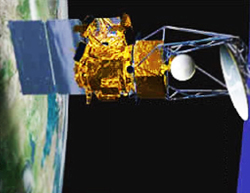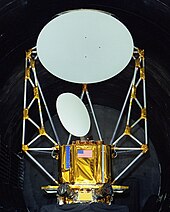Coriolis (satellite)
| Coriolis (P98-2) | |
|---|---|

|
|
| Type: | Weather satellite |
| Country: |
|
| Operator: |
|
| COSPAR-ID : | 2003-001A |
| Mission dates | |
| Dimensions: | 817 kg |
| Begin: | January 6, 2003, 14:19 UTC |
| Starting place: | VAFB , SLC-4W |
| Launcher: | Titan-II (23) |
| Flight duration: | 3 years (originally planned) |
| Status: | in orbit, active |
| Orbit data | |
| Rotation time : | 101.5 min |
| Orbit inclination : | 98.7 ° |
| Apogee height : | 846 km |
| Perigee height : | 825 km |
Coriolis (or P98-2 ) is the name of an experimental weather satellite operated by the US Air Force and the Office of Naval Research (ONR) as part of the Space Test Program . It was named after the Coriolis force discovered in 1775 .
Furnishing
The satellite was based on the LeoStar-3 - satellite bus from Spectrum Astro built. It is designed to use two government-provided experimental payloads in a three-year test mission. These are:
- A 305 kg multi-frequency polarimeter (also called WindSat ), which also houses a radiometer , which was built by the Naval Research Laboratory (NRL). The task of this experiment is to measure the wind speed at sea level . The experiment is mounted on top of Coriolis.
- The 35 kg solar mass imaging device (SMEI for short) built by the University of Birmingham and the University of California in San Diego to monitor solar activity .
A special feature of the Coriolis satellite are the extremely low levels of electromagnetic interference in conjunction with the highly sensitive WindSat radiometer. In addition, it is characterized by system stability that can withstand 30 revolutions per minute.
The WindSat part generates the data for the downlink with its radar, while the SMEI collects information with its three optical cameras. Commands and information are continuously transmitted to the spacecraft via an approximately 1 MB wide interface. Data is stored in the mass storage device and then transmitted to the ground station at up to 51.2 Mbit per second in the X band .
Mission history
Coriolis was delivered to the NRL in July 2001 to test the satellite for vibration . At the same time, the integration of the WindSat experiment into the spacecraft was carried out. The satellite was one on 6 January 2003 aboard Titan-II - launcher in a medium-high orbit started. After more than 14 years, which significantly exceeds the originally planned service life, it is still active.
Another mission
A replica of the WindSat experiment was to be launched in 2018 on a Falcon 9 rocket on board ORS 6 . This plan was canceled in May 2018.
Web links
- Orbit data according to N2YO (English).
- Coriolis (P98-2) on Gunter's Space Page (English).
- Coriolis in the Encyclopedia Astronautica (English)
- Coriolis ( Memento from December 14, 2017 in the Internet Archive ) (PDF) - data sheet from Orbital ATK (English).
Individual evidence
- ↑ Gunter Krebs: ORS 6 (COWVR). In: Gunter's Space Page. October 24, 2018, accessed December 13, 2018 .

